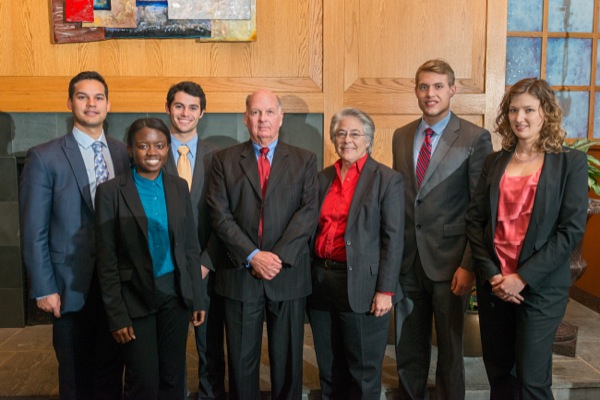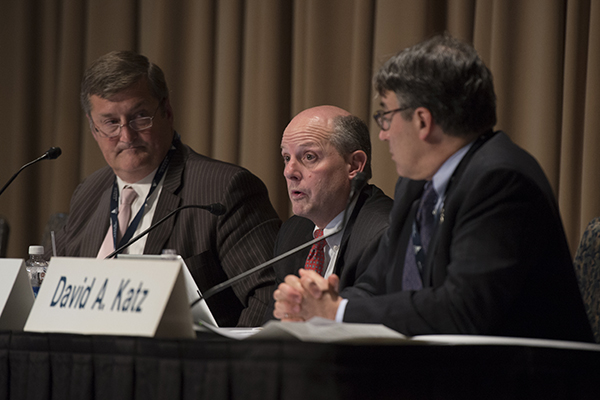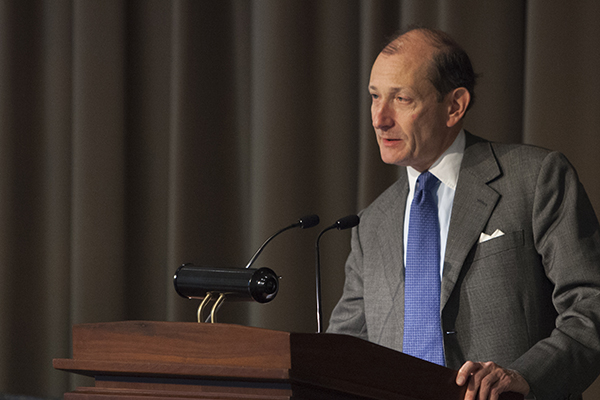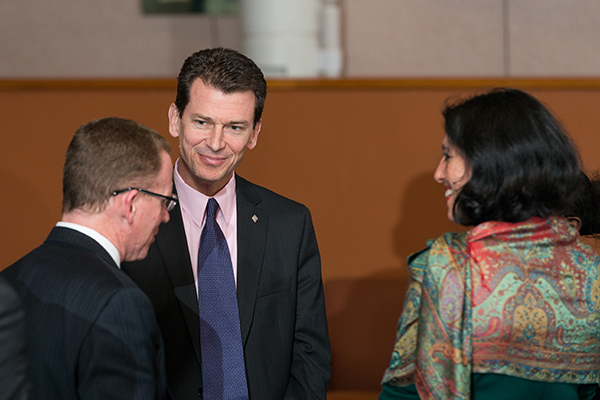

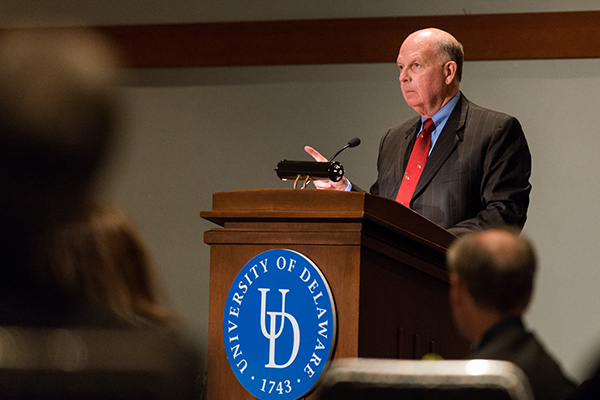
Delaware Law Issues Update
Unique conference brings together national legal, corporate governance communities
12:57 p.m., Dec. 5, 2013--From members of the Delaware judiciary to corporate secretaries and investors, the “Delaware Law Issues Update” held over two days last week on the University of Delaware’s Laird Campus was a who’s who of legal and corporate governance experts from around the country.
The first-time program was hosted by the John L. Weinberg Center for Corporate Governance at UD and the Society of Corporate Secretaries and Governance Professionals, in partnership with the state of Delaware.
Campus Stories
From graduates, faculty
Doctoral hooding
Unique to this event was a focus on the practical implications of trends in Delaware law; six panels not only covered case law but also gave best practice advice on proactive steps to avoid litigation and how to handle difficult situations and outcomes.
Featured speakers included Myron T. Steele, chief justice, and Jack B. Jacobs, justice, of the Delaware Supreme Court; Leo E. Strine Jr., chancellor, and J. Travis Laster and Sam Glasscock III, vice chancellors, of the Delaware Court of Chancery.
When bad things happen to good companies
The first day featured an opening address by Jacobs and then panels with leading corporate and plaintiff attorneys, corporate secretaries and investors.
“Director Fiduciary Duties in Compensation Decisions,” which featured Glasscock, explored recent legal developments that affect boards’ decisions and fiduciary duties relating to executive and director compensation, including claims against directors on say-on-pay votes, and claims that proxies inadequately disclose pay practices.
But another issue that can plague boards is when bad things happen to good companies.
A separate panel by that name examined Caremark-type claims – when companies experience a large, unexpected liability and at least some issues fall squarely within the domain of the board of directors and corporate secretary function and intersect with Delaware law. The panel focused on the duties of the board, including effective oversight in the compliance/Caremark situation.
“There’s no silver bullet,” said one panelist regarding response mechanisms to claims. “Some of dealing with it is common sense, some is experience. You need to think of the probability of an event occurring, what the magnitude could be and try to consider relevant information: is the source credible, is it major or is it a minor HR complaint on a hotline that can be dealt with at the management level on a routine basis?”
Another panelist noted the importance of having an appropriate escalation process that is clearly communicated to the people who are the “eyes and ears of a company.”
“Information may not get bubbled up at the right times and this can be very tricky,” said the panelist. “You don’t always need to escalate issues to senior management and a lot can be handled at a local operating level.”
Ultimately, many panelists advised that the objective is to assess the information at hand, make a good judgment about how much more information you might need, and determine what people really need to be involved to help reach a good decision.
And making a decision, any decision is key, said another panelist.
“Failure to take action when a problem is found can greatly enhance the problem,” advised one panelist. “In the Caremark cases, had they dealt with it, the problem may have stayed small, they would have paid a fine. But penalties are substantially greater and the cover-up is often worse than the crime.”
Getting governance right
During the luncheon keynote address, Charles M. Elson, Edgar S. Woolard Jr. Chair in Corporate Governance and director of the Weinberg Center, delivered an animated review of Delaware’s legal history.
From its small size, “smart” Court of Chancery and expertise in equity, Elson explained why organizations turned to incorporating in Delaware.
“Most organizations used to be incorporated in New York because it was a financial capital center,” said Elson. “But then came the progressives of the trust era, who changed New York corporate law which was then viewed as less favorable to corporate interests. Eventually corporations moved south to Delaware.”
According to Elson, a developing strong corporate bar, legislative interest and its stature as a small state where changes in law could occur relatively quickly gave Delaware a national reputation as a neutral zone. But most important was its commitment to investor protection.
“There were no local interests that dominated corporate law, only the corporate interest to get it right for investors,” said Elson.
The significant corporate experience before one becomes a judge, as well as the presence of corporate lawyers administering the courts also made Delaware attractive, he said.
“Delaware law preserves national, fair balance,” said Elson. “That’s why you’re here. To understand what makes Delaware tick and how you can counsel your clients, boards and investor groups on what this place means, how it really works and why it is so protective of national interest.”
Developments and trends
A panel on “M&A Trends and Developments,” which featured Strine, discussed the latest merger and acquisition deal developments in the context of recent Delaware and other cases, including issues surrounding nondisclosure agreements and standstill agreements and continuing disclosure issues regarding projects and financial advisor disclosure.
The final panel of the day, “Federal and State Judicial Developments and Private Litigation,” addressed the dramatic increase in merger and acquisition litigation that is increasingly pursued in multiple jurisdictions, including the target’s state of incorporation and the state in which its principal place of business is located and the use of forum selection bylaws.
According to a presentation during the panel, regarding multi-forum litigation generally, over 96 percent of merger and acquisition deals over $500 million were challenged in 2012.
“When you’re doing deal litigation the only thing that matters is getting the deal closed,” said one panelist. “You want the least risk of the deal getting disrupted. It is in the organization’s interest to get litigations centralized in one court. There isn’t anything good about multi-forum litigation involving the same deal.”
The panel then focused on the pros and cons of companies adopting exclusive forum provisions in their charters or bylaws that specify a particular forum as the exclusive forum for certain types of stock holder lawsuits, which are typically brought in connection with a deal.
It was noted that in a recent Delaware case, Strine held that the bylaws were valid and enforceable as a matter of Delaware law. The panel also focused on other Delaware cases that directors and officers should know about.
But when it comes to judicial treatment of corporate responses to multi-jurisdictional litigation, like exclusive forum charter and bylaw provisions, another panelist said it wasn’t so cut and dry.
The evening closed with a dinner featuring a keynote address by Steele.
Staying out of trouble
The second day of the conference featured an opening address by Laster.
Following Laster, a panel, “What To Do When An Activist Shareholder Comes Calling,” examined legal and other issues that can arise when an activist investor comes calling.
The panel focuses on the steps companies can take to avoid attracting activists, such as investing in a highly regarded investor relations team, using the right outside advisers and focusing on structural defenses. The panel also focused on the best ways for a company to respond when approached by an activist.
The concluding panel, “Practical Tips on How to Keep the Board Out of Trouble,” covered the nuts and bolts for corporate secretaries, including effective minute-taking and post-meeting follow-up, board and committee presentations and communications.
The panel also addressed considerations when litigation focuses on board processes and records and confidentiality issues concerning board materials, with particular focus on the use of technology and board portals.
About the program
The conference was co-chaired by: Anne Foster, Richards Layton and Finger; Bill Lafferty, Morris, Nichols, Arsht and Tunnell LLP; Rolin Bissell, Young Conaway Stargatt and Taylor, LLP; John Grossbauer, Potter Anderson and Corroon LLP; Karen Valihura, Skadden, Arps, Slate, Meagher and Flom LLP; and David Katz, Wachtell, Lipton, Rosen and Katz.
Article by Kathryn Meier
Photos by Evan Krape, Kathy F. Atkinson and Ambre Alexander




